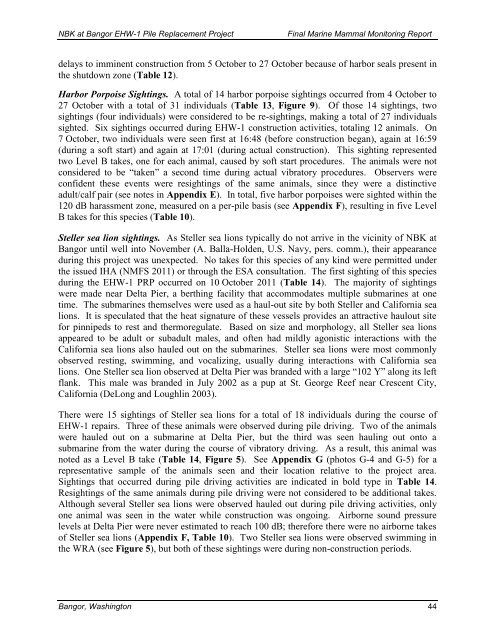Section 1 Introduction - National Marine Fisheries Service - NOAA
Section 1 Introduction - National Marine Fisheries Service - NOAA
Section 1 Introduction - National Marine Fisheries Service - NOAA
Create successful ePaper yourself
Turn your PDF publications into a flip-book with our unique Google optimized e-Paper software.
NBK at Bangor EHW-1 Pile Replacement Project Final <strong>Marine</strong> Mammal Monitoring Report<br />
delays to imminent construction from 5 October to 27 October because of harbor seals present in<br />
the shutdown zone (Table 12).<br />
Harbor Porpoise Sightings. A total of 14 harbor porpoise sightings occurred from 4 October to<br />
27 October with a total of 31 individuals (Table 13, Figure 9). Of those 14 sightings, two<br />
sightings (four individuals) were considered to be re-sightings, making a total of 27 individuals<br />
sighted. Six sightings occurred during EHW-1 construction activities, totaling 12 animals. On<br />
7 October, two individuals were seen first at 16:48 (before construction began), again at 16:59<br />
(during a soft start) and again at 17:01 (during actual construction). This sighting represented<br />
two Level B takes, one for each animal, caused by soft start procedures. The animals were not<br />
considered to be “taken” a second time during actual vibratory procedures. Observers were<br />
confident these events were resightings of the same animals, since they were a distinctive<br />
adult/calf pair (see notes in Appendix E). In total, five harbor porpoises were sighted within the<br />
120 dB harassment zone, measured on a per-pile basis (see Appendix F), resulting in five Level<br />
B takes for this species (Table 10).<br />
Steller sea lion sightings. As Steller sea lions typically do not arrive in the vicinity of NBK at<br />
Bangor until well into November (A. Balla-Holden, U.S. Navy, pers. comm.), their appearance<br />
during this project was unexpected. No takes for this species of any kind were permitted under<br />
the issued IHA (NMFS 2011) or through the ESA consultation. The first sighting of this species<br />
during the EHW-1 PRP occurred on 10 October 2011 (Table 14). The majority of sightings<br />
were made near Delta Pier, a berthing facility that accommodates multiple submarines at one<br />
time. The submarines themselves were used as a haul-out site by both Steller and California sea<br />
lions. It is speculated that the heat signature of these vessels provides an attractive haulout site<br />
for pinnipeds to rest and thermoregulate. Based on size and morphology, all Steller sea lions<br />
appeared to be adult or subadult males, and often had mildly agonistic interactions with the<br />
California sea lions also hauled out on the submarines. Steller sea lions were most commonly<br />
observed resting, swimming, and vocalizing, usually during interactions with California sea<br />
lions. One Steller sea lion observed at Delta Pier was branded with a large “102 Y” along its left<br />
flank. This male was branded in July 2002 as a pup at St. George Reef near Crescent City,<br />
California (DeLong and Loughlin 2003).<br />
There were 15 sightings of Steller sea lions for a total of 18 individuals during the course of<br />
EHW-1 repairs. Three of these animals were observed during pile driving. Two of the animals<br />
were hauled out on a submarine at Delta Pier, but the third was seen hauling out onto a<br />
submarine from the water during the course of vibratory driving. As a result, this animal was<br />
noted as a Level B take (Table 14, Figure 5). See Appendix G (photos G-4 and G-5) for a<br />
representative sample of the animals seen and their location relative to the project area.<br />
Sightings that occurred during pile driving activities are indicated in bold type in Table 14.<br />
Resightings of the same animals during pile driving were not considered to be additional takes.<br />
Although several Steller sea lions were observed hauled out during pile driving activities, only<br />
one animal was seen in the water while construction was ongoing. Airborne sound pressure<br />
levels at Delta Pier were never estimated to reach 100 dB; therefore there were no airborne takes<br />
of Steller sea lions (Appendix F, Table 10). Two Steller sea lions were observed swimming in<br />
the WRA (see Figure 5), but both of these sightings were during non-construction periods.<br />
Bangor, Washington 44
















